I've learnt a little about Sir Herbert Austin recently. Later Baron Austin of Longbridge, he was the man who more than anyone else shaped the landscape of the part of Birmingham where I grew up.
During my youth the car manufacturing plant he founded employed about 25,000 people and covered several square kilometres. Gee, were we proud of it.
All good things come to an end though, and mediocre things too. The cars it produced became more and more mediocre, and the once mighty company shrank, merged, changed its name of few times, got taken over by others from around the world, and eventually gave up the ghost entirely.
 Out of the ashes though...... what a business opportunity. What a huge expanse of real estate. Above is a plan of the redevelopment currently underway, stolen from the website www.newsteelconstruction.com There's going to be housing, shops, parks, commercial and industrial areas galore. There's already a fair few things there, like the shiny new technical college (whose roof partly blew off while I was there!), and the comfortable and spacious Sainsburys supermarket (whose coffee shop provided a welcome respite from the cold, wet weather outside). There's even an Austin Park, with memorial to the good Lord, and a blow by blow account of the rise and fall of his company.
Out of the ashes though...... what a business opportunity. What a huge expanse of real estate. Above is a plan of the redevelopment currently underway, stolen from the website www.newsteelconstruction.com There's going to be housing, shops, parks, commercial and industrial areas galore. There's already a fair few things there, like the shiny new technical college (whose roof partly blew off while I was there!), and the comfortable and spacious Sainsburys supermarket (whose coffee shop provided a welcome respite from the cold, wet weather outside). There's even an Austin Park, with memorial to the good Lord, and a blow by blow account of the rise and fall of his company.
 One unexpected finding during my extensive research this evening (ie. I read the Wikipedia entry): He spent several formative years in Australia! Between 1884 and 1893 he was here, based in Melbourne, and later Sydney. He married a Melbourne girl, and he was involved in designing and building printing equipment, gas engines, locomotive boilers, gold mining equipment, and eventually a sheep shearing machine! The latter enterprise was with one Frederick Wolseley, who was also later to give his name to a car brand. It was only after his return to England that Austin became interested in motor cars.
One unexpected finding during my extensive research this evening (ie. I read the Wikipedia entry): He spent several formative years in Australia! Between 1884 and 1893 he was here, based in Melbourne, and later Sydney. He married a Melbourne girl, and he was involved in designing and building printing equipment, gas engines, locomotive boilers, gold mining equipment, and eventually a sheep shearing machine! The latter enterprise was with one Frederick Wolseley, who was also later to give his name to a car brand. It was only after his return to England that Austin became interested in motor cars.
He was born in south east England, but buried in a church cemetery in the Lickey Hills.

















































